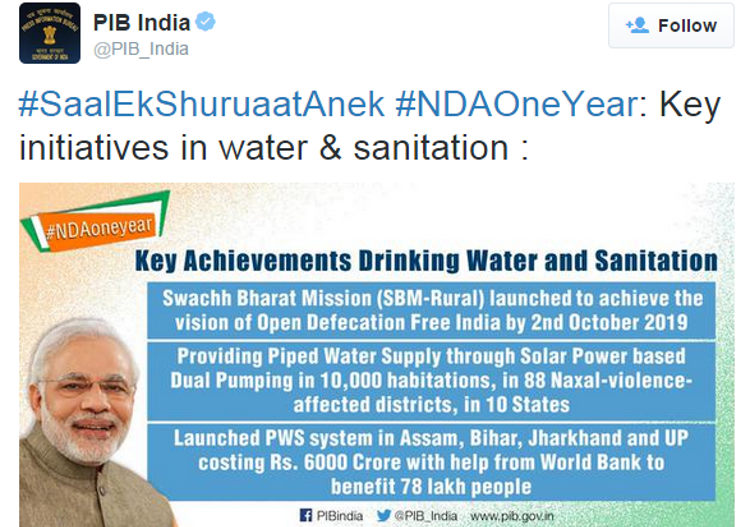Sanitation Ministry: Old Wine, New Bottles

A blaze of publicity has showcased the sanitation and water-supply achievements of Prime Minister Narendra Modi's government, such as the rural version of the Swachh Bharat Mission (SBM-Rural), or Clean India Mission, which is an existing scheme renamed. Another supposedly new programme, piped-water supply through solar-power-based dual pumps, was launched by the previous government as well.
There are four problems we found with the claims. We emailed our findings to the ministry last week, requesting comment. There was no response.
1. Swachh Bharat Mission (SBM-Rural): New name, old scheme Claim: SBM-Rural launched to achieve open-defecation-free India.#SaalEkShuruaatAnek #NDAOneYear: Key initiatives in water & sanitation : pic.twitter.com/79NZPrQizC
— PIB India (@PIB_India) June 6, 2015Check revealed: SBM-Rural is an amendment of an earlier rural sanitation programme, Nirmal Bharat Abhiyan, started on April 1, 2012, according to ministerial responses in the Rajya Sabha.
2. Number of toilets constructed: Comparison with previous year misleading Claim: 5.85 million toilets constructed during 2014-15 as compared to 4.97 million during 2013-14.Swachh Bharat Mission gets a boost. #SaalEkShuruaatAnek #MyCleanIndia pic.twitter.com/hVtBkrUVDe
— PMO India (@PMOIndia) May 26, 2015Check revealed: There may be a modest (17.7%) increase in toilets constructed between 2013-14 and 2014-15. However, Lok Sabha data reveals that for four consecutive years, 2008-09 to 2011-12, significantly greater number of toilets were constructed than in the first year of the current government. 11.3 million toilets constructed during 2008-09, 12.4 million in 2009-10, 12.2 million in 2010-11 and 8.8 million in 2011-12 – respectively 92%, 111%, 109% and 50% more than the number of toilets built during Modi's first year in office.
| Year | Household Latrines Constructed |
|---|---|
| 2008-09 | 11,265,882 |
| 2009-10 | 12,407,778 |
| 2010-11 | 12,243,731 |
| 2011-12 | 8,798,864 |
| 2012-13 | 4,559,162 |
| 2013-14 | 4,976,294 |
| 2014-15 (upto Feb 2015) | 4,012,185 |
| 2014-15* | 5,855,666* |
Source: Lok Sabha 1, 2, 3, 4; *according to 2014-15 government report card
3. Piped water supply (PWS) through solar power-based dual pumpsClaim: Providing PWS through solar-power-based dual pumps, water pumps that utilise solar power during the day and act as a normal hand pump when the solar energy is not available, in 10,000 rural habitations in 10 states.
Check revealed: The project that supports states to implement solar-power-based dual pumps to supply piped water in these 10,000 rural habitations was proposed under the 12th Plan (2012-2017).
The project costs Rs 553.3 crore, to which the National Clean Energy Fund contributes Rs 221.3 crore (40% of the project cost). The remaining Rs 332 crore is to be co-funded by state and central governments under the National Rural Drinking Water Programme (30% each by central and state governments).The scheme was supposed to be completed in 18 months.
| STATE | Target Habitation |
|---|---|
| ANDHRA PRADESH | 153 |
| BIHAR | 281 |
| CHATTISGARH | 960 |
| JHARKHAND | 1072 |
| MADHYA PRADESH | 669 |
| MAHARASHTRA | 38 |
| ORISSA | 1762 |
| UTTAR PRADESH | 96 |
| WEST BENGAL | 393 |
| Total | 5424 |
Source: Rajya Sabha via Press Information Bureau
4. World Bank loan for piped water supply: approved by previous governmentClaim: Piped water supply launched in Assam, Bihar, Jharkhand and Uttar Pradesh, with Rs 6,000 crore from the World Bank.
Check revealed: The rural drinking water and sanitation project for low-income states had been under examination since 2012 and was approved on January 2, 2014 by the cabinet committee on economic affairs.
The project is expected to directly benefit about 7.8 million people in 33 rural districts of the four states. The project cost of Rs 6,000 crore will be financed by the government of India [the National Rural Drinking Water Programme will contribute 33%], state governments (16%), beneficiary contribution (1%) and external financing (World Bank-International Development Association, 50%).
The central government will repay Rs 3,150 crore ($500 million) loaned by the World Bank over a period of 25 years with 1.25% interest.
Tomorrow: Department Of Posts: Old Plans On Track You can read the earlier pieces in our series below: 1) Overblown, Misleading Claims By 14 Modi Ministries 2) Agriculture Ministry: Old Schemes Renamed, Other Misleading Claims 3) Health Ministry: New Claims, No New Programmes 4) Power Ministry: Marginal Improvements 5) Railway Ministry: 8 Achievements That Really Aren’t 6) Road Transport Ministry: Continues UPA’s Work, Contradicts Own Data 7) Telecom Ministry: Wrong Claims, Bad Maths(Manoj K is a graduate of the Indian Institute of Technology, Delhi, and the founder of the Centre for Governance and Development. He has a special interest in transparency and accountability in governance and has spearheaded several projects on these subjects. He can be contacted at manoj@cgdindia.org.)
References: Fact Check 1- Rajya Sabha: Unstarred Question No 281, Answered On 27.04.2015
- Rajya Sabha: Unstarred Question No 1951, Answered On 16.03.2015
- Lok Sabha: Unstarred Question No 1266, Answered On 12.12.2013
- Lok Sabha: Unstarred Question No 2757, Answered On 12.03.2015
- Lok Sabha: Unstarred Question No 685, Answered On 24.11.2011
- Lok Sabha: Unstarred Question No 400, Answered On 09.08.2012
- Rajya Sabha Unstarred Question No 1106, Answered On 16.12.2013 via Press Information Bureau
- Lok Sabha: Unstarred Question No 5530, Answered On 10.05.2012
- Press Information Bureau: Cabinet Committee On Economic Affairs


